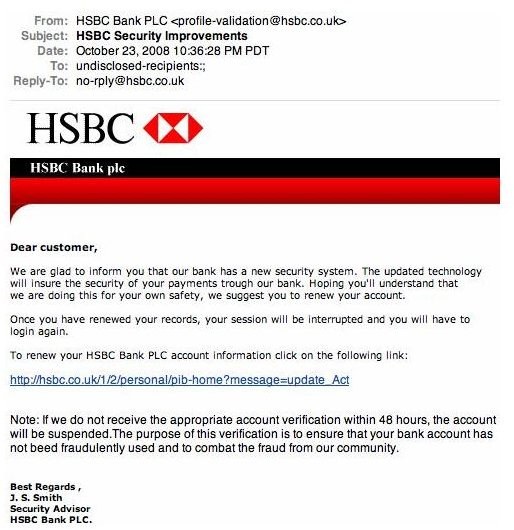Some Top Phishing Threats To Be Aware Of
Phishing Scams Explained
Potentially the most dangerous online scam threatening innocent web users is phishing.
“Phishing” is the name given to a particular type of scam in which a criminal will attempt to get your personal details by posing as someone trustworthy, such as a bank, auction site or IT administrator.
Whenever such cyber criminals are successful in acquiring your personal details, they have successfully committed an act of identity theft, and their first aim will be to find out what they can do by posing as you.
They might try to open a new bank account, empty your current account, take out extra borrowing on your mortgage or even use you to launder money that they have earned in other criminal activities.
Whatever their aims, phishing is illegal and a threat to everyone.
Phishing Explained
You’ve probably already been the victim of a phishing attempt – while some cyber criminals still try to attempt to get information from you via phonecalls purporting to be from a utility or bank, the majority of top phishing threats come via email.
Some of these attempts are so well known they have gone into popular culture – one such example is an email claiming to be from the deposed king of an African, Far East or Eastern European nation who has a vast fortune that he is willing to share with you if you can lend him $20,000 to pay off the corrupt bank manager holding his funds.
Most commonly, phishing attempts take the form of emails that look as though they have come from banks, credit card and utility companies.
In truth, these emails don’t come from who they say they do. Most banks, credit card companies and utilities will not even have your email address, and none will require you to submit information by clicking a link in an email.
Top Phishing Threats Affecting You
Phishing threats affect us all. The first rule of thumb in protecting against this is to never give out your details over the web or a telephone, unless you are certain you are communicating with a genuine organization.

Because phishers can create emails and websites that look like the real thing, it is easy to be fooled into submitting your logon information, password and other security codes into a fake website.
Here is a list of some of the top phishing threats that might affect you:
Amazon – as of July 2009, Amazon was the top brand to be exploited by phishers.
Facebook – users of the popular social networking site are subject to threats both within Facebook and via email. Using the services security settings you can reduce the threat from phishing attacks by making your contact and email details private.
eBay – the popular auction site is another big name that is often mimicked in order to gain personal information.
HSBC, Santander, CommonWealth Bank – customers of these large international banks have also been the subject of phishing scams.
You might have noticed that some of these sites are very popular. Phishers use tools to “mine” email addresses and other contact details wherever possible in order to draw you into their scam. Awareness of these methods is the first step in protecting yourself from the threat.
Protection from phishers can also be acquired by regularly updating your security software in order to prevent you from innocently submitting information to top phishing threats. If you use a desktop email client and your security software doesn’t have any inbox protection, you should consider a specialist application to protect your emails. Check out The Best 5 Anti-Phishing Plugins for more ideas on how to reduce the threat of phishing.
